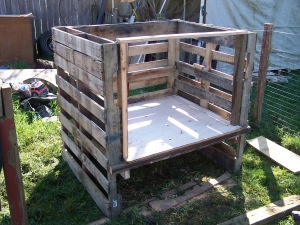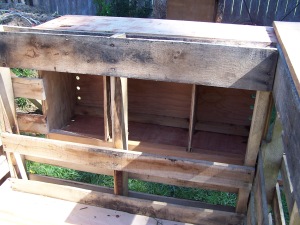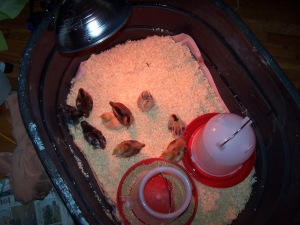 WE DID SOMETHING RIGHT WITH OUR CHICKENS
WE DID SOMETHING RIGHT WITH OUR CHICKENS
If I had the space I’d have at least one-hundred chickens roaming the property. That’s how much I love raising these birds.
We’ve had our birds now for about two years I guess. We haven’t lost a one from the original flock, so I’m writing this from a soapbox constructed by a perfect success rate.
Knock on wood!
Before it sounds like I’m tooting my own horn, let me tell you my success rate with quail is considerably less. I think we’ve lost close to forty of our quail due to my lack of knowledge and plain stupidity, so consider that as we go along. In the case of chickens, you can learn from my success. In the case of quail, you can learn from my failures.
A LITTLE BACKGROUND
We live in Olympia, Washington. In our city we are allowed five hens and no roosters. I’m okay with that. We don’t pay much attention to the hens requirement, but I’m okay with the rooster regulation. They are noisy s.o.b.s at four in the morning and I get it that some people are turned off by the crowing.
So check your city ordinances before you consider raising chickens.
We raised ours from chicks. We drove out to a guy’s farm and picked out six as I recall. We drove back out three months later and swapped three roosters for three hens. Sexing a chick is tough and I’m not good enough at that talent yet….but I will be.
Anyway, that’s how we started, but before we ever bought the chicks (for $3 each) we had to get ready for chickens.
A CHICKEN ENCLOSURE
You can go out and spend a thousand bucks on a pre-made chicken coop/enclosure, or you can do what we did and build yours from scrap lumber and whatever else you have handy. There are several things that are non-negotiable when building a chicken coop so listen up. You need it to be completely secure from predators, you need it to have nesting boxes and you need it to have a roosting pole for the chickens to sleep upon. Those three are absolutely necessary.
There are secondary considerations as well. The placement of the coop is fairly important. You want the coop to receive adequate sunshine during the winter but adequate shade during the summer. You want it facing away from brutal winter winds. And you want it made in such a way that it is easy to clean because, after all, you will be cleaning it. Chickens are pretty consistent about not cleaning their own coop.
Our coop is basically made with two large wooden pallets, so the interior is about 40”x48” in size. That’s just big enough for our six hens to rest at night. We made it in such a way that their food and water is stored underneath the coop, and their nesting boxes are flush to the back wall so they don’t take up interior space. You can see from the attached pictures what I’m talking about.
The entire front panel of the coop is on hinges so it is easy to open up for cleaning. In addition there is a chicken door for easy access for the chickens. The entire coop is tightly sealed so no critter/predator can enter at night.
THE CHICKEN RUN
Our chickens are free-range, meaning they have the run of the backyard. Not so when they were younger, though; once they were put outside for good, at about four weeks, we attached a chicken wire enclosure to their coop. The “chicken run” was twenty feet in length and completely sealed with the chicken wire to keep hawks and owls from swooping down and grabbing the four-week old chicks.
We removed the chicken run at about six weeks. By that age chickens are smart enough to hide under their coop if they hear a hawk screech.
We let the chickens out in the morning when it is light enough. At night they enter their coop at dusk without any prodding and we lock them in. Never…never…leave your chickens outside at dusk, early dawn or nighttime. Once raccoons and possums start roaming, your chickens need to be locked up away from harm.
CHICKEN FEED
Any farm and garden center will have fifty pound bags of chicken feed you can buy. A fifty pound bag lasts us a long time with our six hens. Most of the time they forage for their own food, scratching in the dirt for bugs and worms. We supplement all that with some table scraps. The girls love watermelon. They love pasta and rice. As long as we don’t give them too much of those things our girls are fine. Our chickens have never been sick so again, we must be doing something right.
Always make sure your chickens have easy access to water. Always! During the winter this is a real issue if you have cold weather, so plan on some arrangement where their water will not freeze up.
LAYING EGGS
Hens lay eggs, just like human females. They do not need a rooster to lay an egg. Let’s get that myth out of the way immediately. The only reason to have a rooster is if you want fertilized eggs to raise more chicks.
Chickens will lay eggs, on average, five or six days per week during the main laying season. They need twelve to fourteen hours of daylight to lay on a regular basis, so our girls lay from April to early October. They could lay during the winter if we provided artificial lighting for them but we don’t choose to do so.
Most of the time our hens will lay their eggs in their nesting boxes, but occasionally they feel a bit adventurous. Don’t be surprised if your hens lay under bushes. It doesn’t mean anything is wrong; it just means your hen was feeling a bit cantankerous.
TIMELINE
Just to give you an overview, this is the timeline from purchase to adulthood:
- Newborn chicks go to a brooder (Tupperware bin and heat lamp)
- Remove chicks from brooder at about four-six weeks and take them outside to the coop and run (provided the weather is warm enough)
- By six weeks they can be set loose to free-range if that’s what you choose to do
- By eighteen weeks they should be laying eggs.
That timetable is an estimate so don’t quote me on it.
How long does a good hen live? I can’t answer that. There are so many factors that it’s impossible to say. Plan on a few years at least. You should be getting eggs for three or four years at least. Some will lay longer; some will not. Some will live longer; some will not.

CHICKEN BREEDS
Do your research. I don’t have enough space here to list all the chickens available. I can tell you that the best egg-producers are Leghorns, Rhode Island Reds, Light Sussex, Plymouth Rocks, Cuckoo Morans and Barred Rocks. If you are raising chickens for meat then look at the Cornish, Cornish Rock, Jersey Giant, Plymouth Rock and Orpington.
Talk to anyone who raises chickens and they will all have their own personal preferences and opinions.
WHAT ABOUT THE WEATHER?
Chickens are pretty hardy birds. Last winter the temps dipped into the low twenties and the birds were fine. If you live where it really gets cold you can always run an extension cord out to the coop and attach a heat lamp. If it rains hard the chickens will get out of the rain. If it’s real hot they will go to the shade. Snow confuses them but they muddle through it. Just make sure they have access to fresh water at all times and you’ll be fine.
ONE FINAL NOTE
My good friend Cristen requested that in the future I give all of you some idea regarding cost of items I mention. In my last blog I mentioned that ½” hardware cloth was the best to use for enclosures. That “cloth” costs about $1 per foot for the three foot wide, and $1.50 per foot for four foot wide. Poultry netting, also known as chicken wire, costs about fifty or sixty cents per foot.
Thanks for the suggestion, Cristen. I’ll try to be better about that in the future.
ANYTHING ELSE?
If you have questions just drop me a line at holland1145@yahoo.com or ask your question in the comment below. I’ll do my best to answer them.
I’ve said this before and I’ll say it again: I’m amazed more people don’t raise chickens. I find them enjoyable, personable, intelligent and great producers of food. Why some communities don’t allow them is a mystery to me.
I hope you give it a try. I don’t think you’ll be disappointed in the experience.
Bill
Great post, Bill. But did your hens really start laying at 8 weeks? My Easter Egger pullets are 17 weeks and haven’t started laying yet. (One of their sisters, who lives at my sister-in-law’s house, did lay a tiny egg last week at 16 weeks.) My others didn’t start laying until around 26 weeks. But I always thought 18 weeks was the normal timeline for laying hens.
LikeLike
LOL…does it say eight weeks? Sorry about that, I’ll go change it..eighteen is what I meant to write. Duh!
LikeLike
I wondered what sort of super chickens you were raising out there. I feel much better now about my slackers. 🙂
LikeLike
Thanks for catching that, Deb. I missed it on three read-throughs. No super chickens here.
LikeLike
This is excellent, Bill. And, it is just the right amount of information – not too little and not so much that it is overwhelming. I’m going to enjoy learning from your experiences.
LikeLike
I’m glad to hear that, Marlene. It’s hard for me to distill so much into a relatively small article. I’m glad you didn’t think it was too much. Thanks for saying that.
LikeLiked by 1 person
Hi Bill–our neighbors have chickens and every once in a while, they give away eggs when they have too many of them–We cannot have roosters in Alameda either–but we do have a big urban farmer movement—so chickens are a growing commodity here–pun intended–Love your coop by the way
LikeLike
Audrey, I love hearing that other communities are moving in this direction. Thanks for sharing that….and nice pun. 🙂
LikeLike
Thank you for sharing!
LikeLike
Correction of the nsme
LikeLike
Thank you Michael my friend.
LikeLike